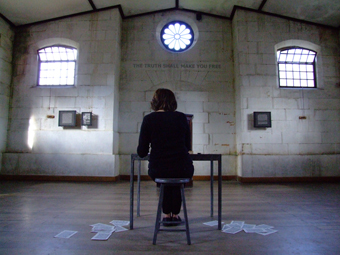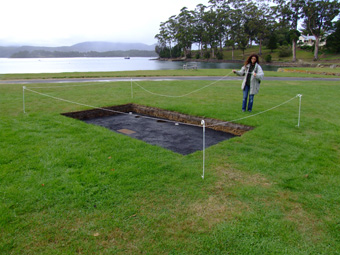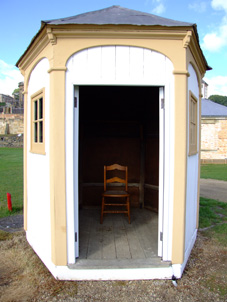 |
Brigita Ozolins, The Truth Shall Make You Free photo Bec Tudor |
Peering into the rectangular cutting of an excavation site, roped off in official fashion, I see the puzzling sight of bitumen inset with road disk markers and a drain cover. The accompanying interpretation boards displaying reproduced landscape paintings of the penal colony offer little clarification. It takes a minute and then I realise with amusement that what I’m looking at is a car parking space. Lucy Bleach titles this mock archaeological dig Reserved. It pokes fun at the visitor’s romanticised idea of history as static, and playfully queries what future generations might deem worthy of preservation from the present.
 |
Lucy Bleach, Reserved photo Bec Tudor |
In the quaint waterside Sentry Box I discover Matt Warren’s sound installation Cantus 35. A single wooden chair invites me to enter the dark cubicle and, once seated I look out to a glorious view of the sparkling sea. Around and behind me harmonic tones toll, swell and diminish, return, overlap and suspend. The soundscape is melancholy, enduring and emotive. My time with this work and this spot is intensely private. When I reluctantly draw myself out of this state of meditation I read that Cantus 35 is a response to the unforgettable sound of gunshots heard in radio newscasts during the Port Arthur massacre of 1996. Comprising 35 tones, this work pays tender tribute to each individual who lost their life. Warren is brave to have tackled this most recent dimension of the site’s tragic history, and he is the sole artist to do so.
 |
Matt Warren, Cantus 35 photo Bec Tudor |
I discover Brigita Ozolins seated at a small desk in the oppressive Separate Prison Chapel. Her feet neatly together, the artist at first appears a studious pupil. However, with nibbed pen and bottle of ink, she carefully writes over the pages of a printed book in an action reminiscent of the ‘lines’ naughty children were once given as punishment. When she fills a page she tears it out letting it drift to the floor before beginning the next. Her script repeats the statement she faces on the wall above the pulpit: The Truth Shall Make You Free. Ideas of truth and freedom must have seemed abstract for the incarcerated, especially here, where solitary confinement epitomised disempowerment and voicelessness. This defiant performance is one part of Ozolins’ tribute to inmate Henry Savery (convicted for forgery) believed to be Australia’s first novelist, who died and is buried at Port Arthur. She is writing on the pages of Quintus Servinton, Savery’s autobiographical novel. Writing ‘their truth’ must have provided precious self-affirmation and escapism for those convicts lucky enough to be literate.
Obviously not all visitors appreciate artistic intervention as part of their tourist experience. I see curiosity dissipate in a puff of annoyance for several people when the realisation hits that this is art. Cameras are lowered and retreats hastily made. However, I am impressed that most visitors are willing participants in critical analysis of the heavily mediated experience for which they have paid handsomely. Those who’ve bought Lucia Usmiani’s fold-out photographic mementos of the Port Arthur “red posts”, “pieces of ground”, “seats for sitting” etc. from the gift shop, for example, voluntarily completed the consumerist loop of the artist’s witty piece. I had a wonderful time.
The Port Arthur Project involves 25 artists working across sculpture, photography, furniture design, performance, printmaking, sound, video and other media. And there are 23 temporary, indoor and outdoor, site-specific installations distributed throughout the extensive site. Curators Noel Frankham and Julia Clark have coordinated a pluralistic reinterpretation of this complex site that is coherent and accessible—a considerable achievement given stringent heritage protocols and the minefield of this history: colonisation, Aboriginal genocide, brutal penal colony, 1996 massacre and part of the huge tourism economy in Tasmania.
Unlike the majority of visitors who will inadvertently stumble across the works in the Port Arthur Project, I was familiar with the territory and on a dedicated mission to locate these artistic treasures. I reflect now that my attempt to experience the exhibition free from ‘tourism’ perhaps made me as much a plunderer of the site as those seeking macabre thrills from Port Arthur’s tales of hardship and cruelty. I disregarded other narratives I deemed less interesting or relevant to me at that time. This is ironic given the works themselves bring to light the untold stories of convict sexuality, women and children and such under-recognised histories as those of the Indigenous inhabitants. If I were to see the show again, I think I might join the noisy guided tour group to get the full Port Arthur Project experience: contemporary site-specific art in an historic place.
Port Arthur Project: Re-interpreting Port Arthur Historic Site through Contemporary Visual Art, curators Noel Frankham & Julia Clark, artists Christl Berg, Lucy Bleach, Tracey Cockburn, Nicole Ellis, Anne Ferran, Linda Fredheim, Ruth Frost, Lola Greeno & Vicki West, Fiona Hall, Leigh Hobba, Colin Langridge, Fiona Lee, Karen Lunn & Milan Milojevic, Anne MacDonald, Anne Mestitz, James Newitt, Brigita Ozolins, Justy Phillips, Helena Psotova, Alyssa Simone, Lucia Usmiani, Matt Warren and Elizabeth Woods; Port Arthur Historic Site, Arthur Highway, Tasman Peninsula, presented by Tasmanian School of Art, University of Tasmania & Port Arthur Historic Site & Ten Days on the Island, March 16 – April 11
Bec Tudor presented a paper at the symposium Revelations… in Hobart, held in conjunction with the Port Arthur Project.
Bec Tudor is a writer and researcher based in Hobart. Her interests include fine art, philosophy, environmental thought, education and community.
RealTime issue #78 April-May 2007 pg. web
© Bec Tudor; for permission to reproduce apply to [email protected]








 back
back